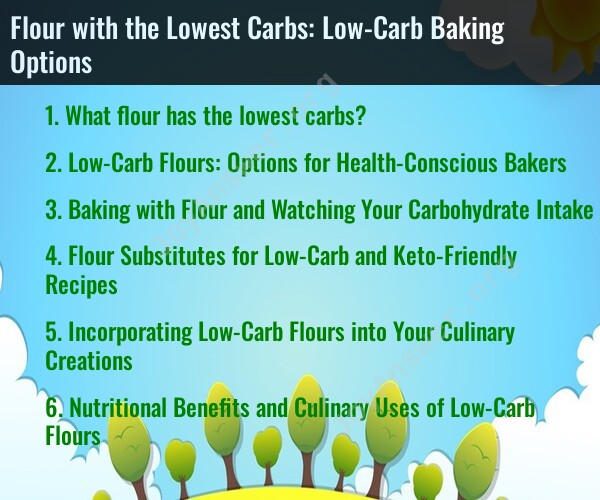What flour has the lowest carbs?
If you're looking for flour with the lowest carbs for low-carb baking, you may want to consider alternatives to traditional wheat flour, which is relatively high in carbohydrates. Here are some low-carb flour options:
Almond Flour: Almond flour is made from finely ground blanched almonds and is a popular choice for low-carb baking. It's lower in carbs than wheat flour and has a slightly sweet, nutty flavor. It's also a good source of healthy fats and protein.
Coconut Flour: Coconut flour is made from dried, ground coconut meat. It is very low in carbohydrates and high in fiber, making it an excellent choice for low-carb and gluten-free baking. It has a mild coconut flavor.
Flaxseed Meal: Flaxseed meal, which is ground flaxseeds, is low in carbs and rich in fiber and healthy fats. It can be used as a flour substitute in recipes, especially for those following a low-carb or keto diet.
Psyllium Husk Powder: Psyllium husk is a fiber supplement that can also be used in low-carb baking. It's very low in carbs and can help provide structure and moisture to baked goods.
Hazelnut Flour: Hazelnut flour is similar to almond flour in terms of low-carb content and can be used in various baked goods. It has a mild, nutty flavor.
Soy Flour: Soy flour is relatively low in carbs and is a good source of protein. It's a versatile option for low-carb baking, although some people prefer to limit soy in their diet due to potential allergens or concerns about soy's effects on hormones.
Chickpea Flour (Garbanzo Bean Flour): Chickpea flour is lower in carbs compared to wheat flour and provides a source of plant-based protein. It's commonly used in recipes like socca (a type of pancake) and as a thickener in sauces.
Lupin Flour: Lupin flour, made from lupin beans, is a relatively new low-carb flour option. It's high in protein and fiber, making it a good choice for low-carb baking.
When using these low-carb flours in your baking, it's essential to understand that they can have different properties, textures, and flavors compared to traditional wheat flour. You may need to adjust your recipes and experiment to achieve the desired results. Additionally, low-carb flours often require more moisture or binding agents in recipes to maintain the right texture.
Keep in mind that the exact carb content can vary between brands and processing methods, so it's a good practice to check the nutritional labels when purchasing low-carb flours.
Low-Carb Flours: Options for Health-Conscious Bakers
Low-carb flours are a great option for health-conscious bakers who are looking to reduce their carbohydrate intake. There are a variety of low-carb flours available, each with its own unique flavor and texture. Some popular low-carb flours include:
- Almond flour: Almond flour is made from finely ground almonds. It is a good source of protein and fiber, and it has a slightly nutty flavor. Almond flour can be used to make a variety of baked goods, such as cookies, muffins, and pancakes.
- Coconut flour: Coconut flour is made from the dried and ground meat of coconuts. It is very high in fiber and low in carbohydrates. Coconut flour has a slightly sweet flavor and a dense texture. It is often used to make low-carb breads and desserts.
- Flaxseed meal: Flaxseed meal is made from ground flaxseeds. It is a good source of omega-3 fatty acids and fiber. Flaxseed meal has a slightly nutty flavor and a gritty texture. It is often used to add fiber and nutrients to low-carb baked goods.
- Psyllium husk powder: Psyllium husk powder is made from the ground husks of psyllium seeds. It is a very good source of fiber and has no carbohydrates. Psyllium husk powder is often used to thicken and bind low-carb baked goods.
Baking with Flour and Watching Your Carbohydrate Intake
When baking with low-carb flours, it is important to keep a few things in mind:
- Low-carb flours absorb liquid differently than traditional wheat flour. You may need to add more eggs or other wet ingredients to your recipes.
- Low-carb flours can give baked goods a different texture than traditional wheat flour. Baked goods made with low-carb flours may be denser or more crumbly.
- It is important to experiment with different recipes and flours to find what works best for you.
Flour Substitutes for Low-Carb and Keto-Friendly Recipes
Here is a table of flour substitutes for low-carb and keto-friendly recipes:
| Traditional Wheat Flour | Low-Carb Flour Substitute |
|---|---|
| All-purpose flour | Almond flour, coconut flour, flaxseed meal, psyllium husk powder |
| Bread flour | Almond flour, coconut flour, flaxseed meal, psyllium husk powder |
| Cake flour | Almond flour, coconut flour |
| Pastry flour | Almond flour, coconut flour |
| Self-rising flour | Almond flour, coconut flour, baking powder, salt |
Incorporating Low-Carb Flours into Your Culinary Creations
Low-carb flours can be used to make a variety of culinary creations, including:
- Baked goods: Low-carb flours can be used to make a variety of baked goods, such as cookies, muffins, pancakes, breads, and cakes.
- Pizza crust: Low-carb flours can be used to make a pizza crust that is both delicious and low in carbohydrates.
- Breaded foods: Low-carb flours can be used to bread foods, such as chicken, fish, and vegetables.
- Thickeners: Low-carb flours can be used to thicken sauces and soups.
Nutritional Benefits and Culinary Uses of Low-Carb Flours
Low-carb flours offer a number of nutritional benefits. They are typically high in protein, fiber, and healthy fats. Low-carb flours are also low in carbohydrates, which makes them a good option for people who are trying to lose weight or manage their blood sugar levels.
Low-carb flours can be used to make a variety of culinary creations. They are a versatile ingredient that can be used to replace traditional wheat flour in many recipes.
Here are some tips for incorporating low-carb flours into your culinary creations:
- Start by substituting a small portion of the traditional wheat flour in your recipe with low-carb flour. Gradually increase the amount of low-carb flour until you achieve the desired flavor and texture.
- Add more eggs or other wet ingredients to your recipes to compensate for the different liquid absorption properties of low-carb flours.
- Be prepared for baked goods made with low-carb flours to have a different texture than traditional wheat flour. Baked goods made with low-carb flours may be denser or more crumbly.
- Experiment with different recipes and flours to find what works best for you.
With a little practice, you can easily incorporate low-carb flours into your culinary creations and enjoy all of the nutritional benefits that they have to offer.











